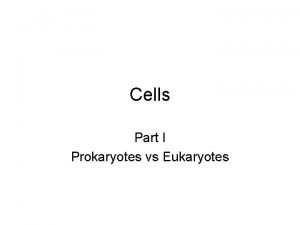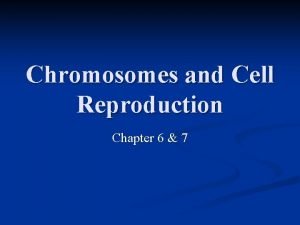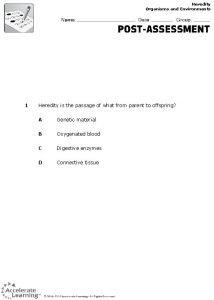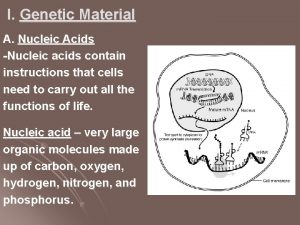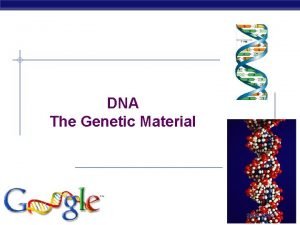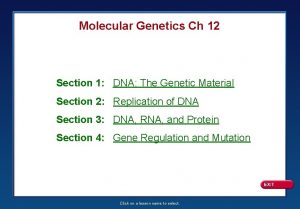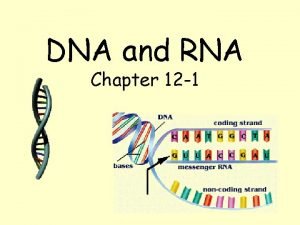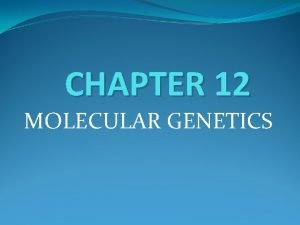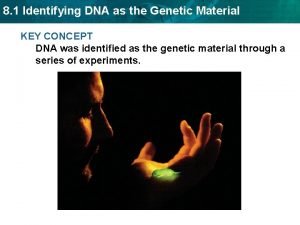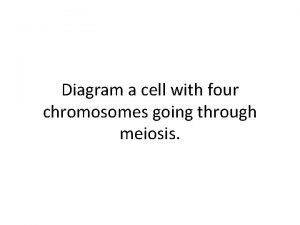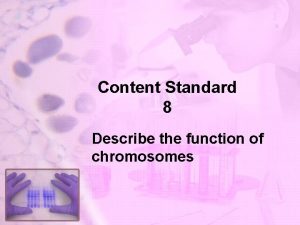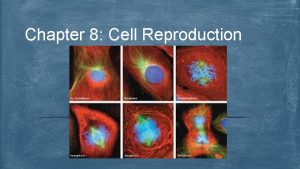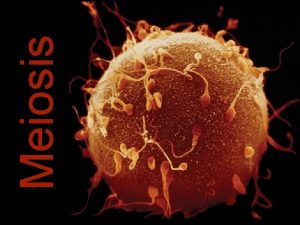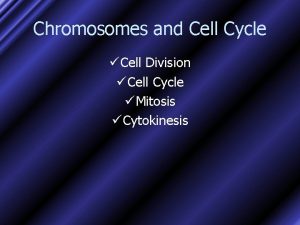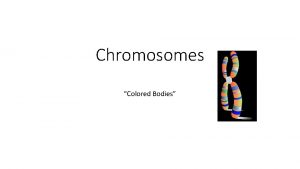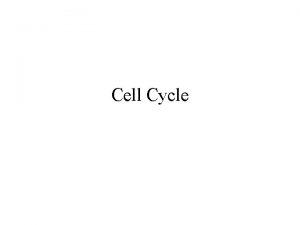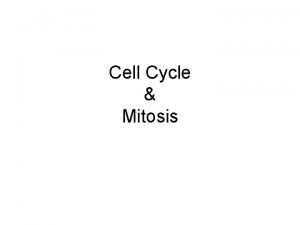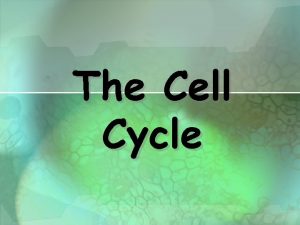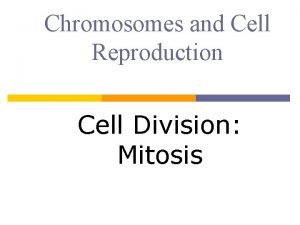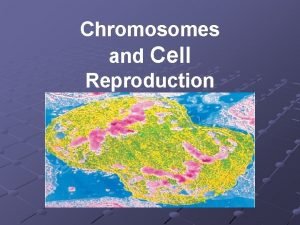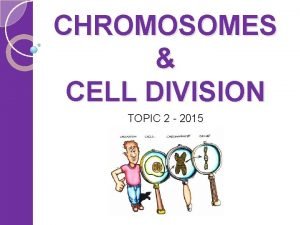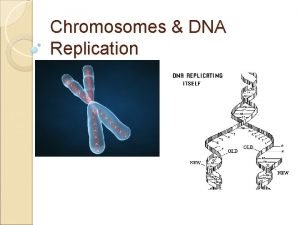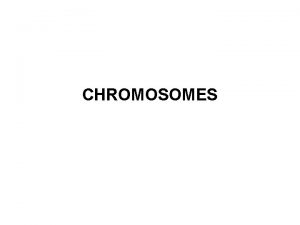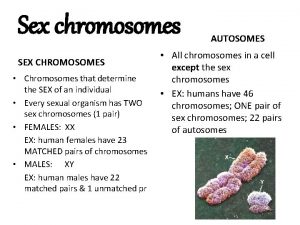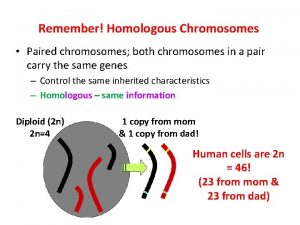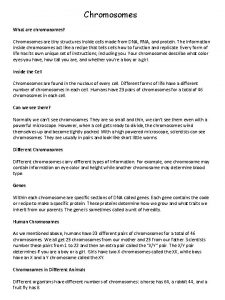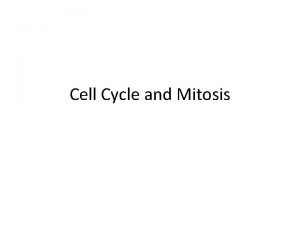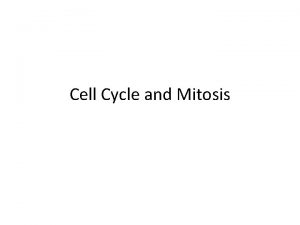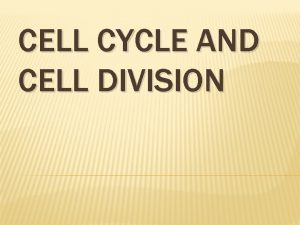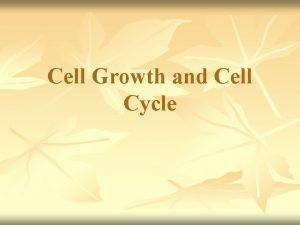Chromosomes structure and Cell cycle Genetic Material in

























- Slides: 25

Chromosomes structure and Cell cycle

Genetic Material in the Living Cells o In a non-dividing cell the nucleus is filled with a thread-like material known as "chromatin". o Chromatin is made up of DNA and proteins (mainly histones and some nonhistone acidic proteins). o Chromosome is a combination of two words, i. e. , “Chroma”-means ‘colour’ and “Somes”-means ‘body’.

Chromosomes are the nucleoprotein structures that carry the genetic information. In eukaryotes they are located in the cell nucleus.

Chromosomes • The eukaryotic genome is made up of DNA/protein complexes called chromosomes. • Gene sequences embedded within chromosomes must still be available for transcription by RNA polymerases and all of the DNA must be capable of being copied by DNA polymerases. • Chromosomes have two main functions: i. To ensure that the DNA is segregated equally to daughter nuclei at cell division, and to ensure that the integrity of the genome is maintained and accurately replicated in each cell cycle. ii. The elements responsible for these functions are centromeres, telomeres and replication origins, respectively

• • Each chromosome carries a couple of thousand genes. Many of these are common to all human beings. So, 99. 9% of your DNA is identical to everyone else's. The remaining 0. 1% influences the differences between us. ü height, hair color and susceptibility to a particular disease. • Environmental factors, such as lifestyle also influence the way we look and our susceptibility to disease

Chromosome number/size • There are mainly two type: i. Somatic chromosome number (2 n), it is the number of chromosome found in somatic, merismatic and tissues of species. ii. Gametic chromosome (n), it is one half of the somatic number basically it is the haploid number. • Chromosome size shows variation depending upon stage of cell division, it is from 1 to 30 in length and diameter from 0. 2 to 2 . • Longest and thinnest chromosome seen during interphase.

Chromosome morphology i. Chromatid: Two chromatids join at the centromere to form a chromosome. ii. Centromere: are attachment points for the mitotic spindle. This attachment is essential for the equal and orderly distribution of chromosome sets to daughter cells, thus it is play a key role in stable chromosome segregation during cell division. Centromere is an A-T regions. iii. Telomere: specialized sequences at the ends of a chromosome that protect and stabilize the entire chromosome, by protecting the ends from nucleases and providing unique mechanisms for the faithful replication of linear DNA molecules. Contain short, repeat TG-rich element.

Types of chromosomes There are four types of chromosomes based upon the position of the centromere. 1) Metacentric: the centromere occurs in the centre and all the four chromatids are of equal length. 2) Submetacentric: the centromere is a little away from the centre and therefore chromatids of one side are slightly longer than the other side. 3) Acrocentric: the centromere is located closer to one end of chromatid therefore the chromatids on opposite side are very long. 4) Telocentric: the centromere is placed at one end of the chromatid and hence only one arm. Such telocentric chromosomes are not seen in human cells.

Comparison between Mitosis and Meiosis

Summary: Property Mitosis Meiosis Occurs during interphase before mitosis Occurs during interphase before meiosis I DNA replication begins Number of divisions One, include prophase, prometaphase, Two, each including prophase, metaphase, anaphase, and telophase Number of daughter cell and genetic composition Occurs during prophase I along with crossing over between nonsister Does not occur chromatids; resulting chiasmata hold pairs together due to sister chromatid cohesion Four, each haploid ( n ) containing half as Two, each diploid (2 n ) and genetically many chromosomes as the parent cell; genetically different from the parent cell identical to the parent cell and from each other Role in the animal body Enable multicellular adult to arise from Produces gametes; number of chromosome zygote; produces cells for growth, repair, sets by half and introduces genetic and in some species, asexual reproduction variability among the gametes Synapsis of homologous chromosomes

Chromosomes and cell division • Multicellular organisms copy their chromosomes before cell division. • They must grow to a mature size. • The nucleus divides, distributing the chromosomes into two equal groups (mitosis). • The cytoplasm then divides (cytokinesis) each part taking a nucleus. Interphase

Review Questions n n n What are and what happens during the phases of the cell cycle? Which proteins are involved in the regulation of the cell cycle? Which cyclins and cyclin-dependent kinases are most important in individual phases of the cell cycle? What are four mechanisms for regulating cyclindependent kinase activity? What role do p 53, p 21, and p. Rb play in the G 1 to S transition?

The cell cycle

The Cell Cycle • Cells must accomplish two basic things during the cell cycle: ü Copying cellular components ü Dividing the cell so that components are distributed evenly to the daughter cells • The alternating “growth” and “division” activities of the cell is called the “cell cycle”. • The “division” activity corresponds to “M phase”. • The “growth” activity corresponds to “Interphase”.

Continue. . • The timing and rates of cell division in different parts of an animal or plant are crucial for normal growth, development, and maintenance. • The frequency of cell division varies with cell type. ü Some human cells divide frequently throughout life (skin cells), others have the ability to divide, but keep it in reserve (liver cells), and mature nerve and muscle cells do not appear to divide at all after maturity.

A molecular control system drives the cell cycle • The cell cycle appears to be driven by specific chemical signals in the cytoplasm. • Fusion of an S phase cell and a G 1 phase cell induces the G 1 nucleus to start S phase. • Fusion of a cell in mitosis with one in interphase induces the second cell to enter mitosis.

Continue. . . • The distinct events of the cell cycle are directed by a distinct cell cycle control system. • These molecules trigger and coordinate key events in the cell cycle. • The control cycle has a built-in clock, but it is also regulated by external adjustments and internal controls. • A checkpoint in the cell cycle is a critical control point where stop and go signals regulate the cycle. • Three major checkpoints are found in the G 1, G 2, and M phases.

• You must know that the order of the cell cycle is: Interphase, Prophase, Metaphase, Anaphase, Telophase, Cytokensis (IPMATC). • From Prophase to Telophase is what is known as Mitosis.

Continue. . . • For many cells, the G 1 checkpoint, the restriction point in mammalian cells, is the most important. • If the cell receives a go-ahead signal, it usually completes the cell cycle and divides. • If it does not receive a go-ahead signal, the cell exits the cycle and switches to a nondividing state, the G 0 phase. Most human cells are in this phase.

Control of the Cell Cycle • The abundance and activity of control molecules pace the cell cycle. • Some molecules are protein kinases that activate or deactivate other proteins by phosphorylating them. • The levels of these kinases are present in constant amounts, but these kinases require a second protein, a cyclin, to become activated. • Levels of cyclin proteins fluctuate cyclically. • The complex of kinases and cyclin forms cyclin-dependent kinases (Cdks). • Cyclin levels rise sharply throughout interphase, then fall abruptly during mitosis.

Cyclins • Four classes Defined by phase of the cell cycle in which they bind their cdk: • G 1/S phase cyclins- bind cdks at the end of G 1, commit cell to DNA replication (cyclin E). • S phase cyclins- bind cdks during S phase, required to initiate replication (cyclin A). • M phase cyclins- bind cdks immediately before M phase, initiate early mitotic (or meiotic) events (cyclin B). • G 1 cyclins- involved in progression through the checkpoint in late G 1 (cyclin D).

M phase Promoting Factor (MPF) • MPF “maturation-promoting factor” or “M-phasepromoting-factor” triggers the cell’s passage past the G 2 checkpoint to the M phase. i. MPF promotes mitosis by phosphorylating a variety of other protein kinases. ii. Stimulates fragmentation of the nuclear envelope. iii. It also triggers the breakdown of cyclin, MPF only active when cyclin levels high enough – triggers passage through G 2 checkpoint. • The M phase checkpoint ensures that all the chromosomes are properly attached to the spindle at the metaphase plate before anaphase. • This ensures that daughter cells do not end up with missing or extra chromosomes.

Rb protein

p 53: Tumor Suppressor Gene

Cells Which No Longer Respond to Cell. Cycle Controls • Cancer cells do not respond normally to the body's control mechanism. ü They divide excessively and invade other tissues ü If left unchecked, they can kill the organism • Cancer cells do not exhibit contact inhibition ü If cultured, they continue to grow on top of each other when the total area of the petri dish has been covered. ü They may produce required external growth factor themselves or possess abnormal signal transduction sequences which falsely convey growth signals thereby bypassing normal growth checks • Cancer cells exhibit irregular growth sequences ü If growth of cancer cells does cease, it does so at random points of the cell cycle ü Cancer cells can go on dividing indefinitely if they are given a continual supply of nutrients
 Chapter 3 cells and tissues
Chapter 3 cells and tissues Which part of the cell contains genetic material
Which part of the cell contains genetic material Founder effect vs gene flow
Founder effect vs gene flow Genetic programming vs genetic algorithm
Genetic programming vs genetic algorithm Genetic programming vs genetic algorithm
Genetic programming vs genetic algorithm What is the difference between genetic drift and gene flow
What is the difference between genetic drift and gene flow What is the difference between genetic drift and gene flow
What is the difference between genetic drift and gene flow Section 10-2 cell division
Section 10-2 cell division Cell cycle and cell division
Cell cycle and cell division Phases of cell cycle
Phases of cell cycle Chapter 6 chromosomes and cell reproduction
Chapter 6 chromosomes and cell reproduction Biology.arizona.edu/cell bio/activities/cell cycle/01.html
Biology.arizona.edu/cell bio/activities/cell cycle/01.html Chapter 12 section 1 dna the genetic material
Chapter 12 section 1 dna the genetic material Heredity defines the passage of genetic material from –
Heredity defines the passage of genetic material from – Chapter 12 section 1: dna: the genetic material
Chapter 12 section 1: dna: the genetic material Chapter 12 molecular genetics answer key
Chapter 12 molecular genetics answer key Genetic material
Genetic material Genetic material
Genetic material Chapter 12 section 1 the genetic material
Chapter 12 section 1 the genetic material On and off
On and off Chapter 12 section 1 dna the genetic material
Chapter 12 section 1 dna the genetic material Section 1 identifying dna as the genetic material
Section 1 identifying dna as the genetic material Result of mitosis
Result of mitosis Funtion of chromosomes
Funtion of chromosomes Diploid vs haploid number
Diploid vs haploid number Mitosis meiosis diagram
Mitosis meiosis diagram

